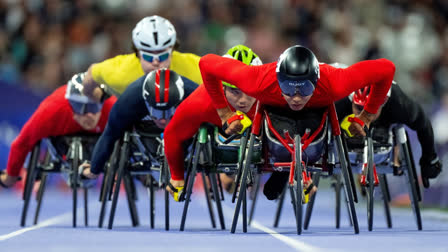Hyderabad:India has been going strong in the Paralympics 2024 so far, winning 15 medals and ranking in the top 20 in the medal tally. Previous edition, India won 19 medals and they are on their way to improving the count this time around with only five short of the target. Paralympics, which started as a rehabilitation activity for war veterans has a participant list of 169 countries.
The athletes are classified into several categories in the competition based on their disabilities and that raises the question of how these categories are determined. Here, we take a look at the factors based on which classification is done and the type of impairments athletes have.
What is classification?
Para-sport always have a threat of being one-sided and predictable with the less impaired athlete having an edge over his opponent. To nullify this threat and bring the athletes on equal terms classification becomes necessary. Classification is the foundation of the Paralympic movement and the athletes are grouped based on the degree of activity limitation they possess due to impairment.
The primary aim of classification is to minimise the impact of impairment on the athletes so that the sporting excellence might get a high value. Also, the classification structure in the Para-sports plays a role in promoting grassroots participation.
Types of impairments
Eligible impairments are divided into three distinct groups - physical impairments, vision impairments and intellectual impairments.
- Physical Impairments - Impaired Muscle Power, impaired passive range of movement, limb deficiency, leg length difference, short stature, hypertonia, ataxia.
- Vision Impairments
- Intellectual Impairements
Minimum impairment criteria for a sport
Each para-sports classification rules describe how severe an impairment must be so that the athlete will be eligible to compete in the sport. The minimum impairment criteria are bound to ensure that the impairment of the athlete affects the extent to which he can carry out the daily activities fundamental to the sport. An example of this criterion is a maximum height limit set for athletes with short stature.
The criteria should be based on scientific research and it changes according to each sport. So, an athlete who is eligible to compete in a particular might not be eligible in the other.
Assessment of sport class for an athlete
After an athlete is designed as eligible for the sports, a classification panel determines the class the athlete will compete in. Some sports are competed only in one class (Para ice hockey or Para power-lifting). On the other hand, other sports include different disciplines and they include athletes of all 10 eligible impairments.
The classification panel is made of a minimum of two members who are trained experts – physicians, physiotherapists, coaches, sports scientists, psychologists or ophthalmologists. The International Sports Federation of that particular sport determines the classifier’s qualifications and the competencies he is supposed to have.
Notable, the classification is based on the activity limitation and not on the basis of the impairment the athlete is having. Thus, if different impairments cause similar activity limitations, two athletes with different impairments might be grouped. For example, in wheelchair racing, athletes with paraplegia and leg amputations race together.
The athletes are sometimes classified multiple times throughout their careers due to the change in nature of impairments and their impact on the limitation of activities. Also, he needs to inform the sport in case of a change in the medical conditions and ask for a reassessment.
